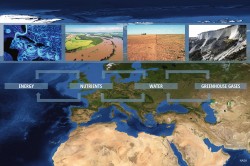press release, 13. September 2017
In the right place at the right time
The Helmholtz Association is setting up a flexible, mobile measuring system for Earth observation
Over the next five years, nine research centres of the Helmholtz Association will collaborate to create a flexible, mobile measuring system for Earth observation: MOSES – Modular Observation Solutions for Earth Systems. Researchers will use this system to investigate how short-term dynamic events such as heatwaves and heavy rainfall are linked to the long-term development of Earth and environmental systems. MOSES is being coordinated at the Helmholtz Centre for Environmental Research (UFZ) in Leipzig.

Photo: NASA / ESKP
What impact do heatwaves have on water resources, vegetation and air quality? How does flooding change terrestrial ecosystems and coastal regions? How do ocean eddies influence marine energy transport and food chains? What amount of atmospheric greenhouse gases is released during the thawing of Arctic permafrost soils?
Global change will affect the Earth system and environment in the short and the long term, both locally and globally. However, there is a lack of knowledge as to how dynamic events limited in space and time impact on the long-term development of Earth and environmental systems.
The new MOSES observation system is designed to close this gap. Over the next five years, the Helmholtz Association is investing almost €28 million in the creation of MOSES, reinforcing its leading role and visibility in international Earth system research.
"The MOSES project will allow us to demonstrate in an impressive way the Helmholtz Association's particular strengths," says Prof. Otmar D. Wiestler, President of the Helmholtz Association. "Nine centres in two research fields, firstly Earth and Environment and secondly Aeronautics, Space and Transport, will be working together on big questions affecting the future of our society. In this interdisciplinary collaboration, they will be able to pool their expertise in a way that uniquely benefits Earth system research as a whole."
Prof. Georg Teutsch, Scientific Managing Director at UFZ, explains: "We intend to build a flexible and mobile observation system that will enable us for the first time to record highly dynamic events at the right time, in the right place and with the necessary resolution in time and space. Measurements like these are the only way in which we can quantify the direct impacts of these events and ultimately investigate their long-term consequences."
"This includes the study of socioeconomic impacts," adds project coordinator Dr. Ute Weber. "We can already assume that events such as heatwaves, heavy rainfall and floods will occur more frequently and with greater intensity in years to come - with the associated costs to society."
The new infrastructure will be designed as a 'system of systems’. The participating centres will develop, miniaturise and automate sensor and measuring systems, which will then be combined to form specific observation modules. These will record energy, water, greenhouse gas and nutrient cycles on the land surface, in coastal regions, in the ocean, in snow and ice regions, and in the atmosphere - but especially the interactions between Earth systems.
However, MOSES does more than combine the outstanding expertise of the participating Helmholtz centres, all of which have extensive experience in the operation of major infrastructures and the management of event-oriented observation campaigns. The mobile infrastructure also represents an important addition to existing national and international monitoring networks and satellite missions, which are mostly designed for long-term, large-scale Earth system observation. Examples include ICOS (Integrated Carbon Observation System), LTER (Long-Term Ecological Research), Helmholtz observatories such as TERENO (Terrestrial Environmental Observatories), COSYNA (Coastal Observing System), CVOO (Cape Verde Ocean Observatory) and the SAMOYLOV Permafrost Observation Station, AWIPEV (Arctic Research Base), and satellite missions like GRACE (Gravity Recovery and Climate Experiment).
The new challenges relating to MOSES lie in the joint development of the modules and the cross-system observation strategy. "An infrastructure like this can’t be constructed or operated by a single institution," says Ute Weber. "But of course the aim is that it will evolve into a platform for national and international cooperation."
The data and results supplied by MOSES will be made available to researchers and other users through the Earth System Knowledge Platform (ESKP), the information portal of the Helmholtz research field Earth and Environment. This data should help to reduce uncertainty in predictions of climate and environmental change and contribute to the development of societal adaptation strategies.
Participating Helmholtz centres:
- Alfred Wegener Institute Helmholtz Centre for Polar and Marine Research (AWI)
- Forschungszentrum Jülich
- GEOMAR Helmholtz Centre for Ocean Research Kiel
- Helmholtz Centre Potsdam - GFZ German Research Centre for Geosciences
- Helmholtz-Zentrum Geesthacht - Centre for Materials and Coastal Research (HZG)
- Helmholtz Zentrum München - German Research Center for Environmental Health
- Helmholtz Centre for Environmental Research - UFZ
- Karlsruhe Institute of Technology (KIT)
- German Aerospace Center (DLR)
Further information
Dr. Ute Weber
UFZ / MOSES Project Management
ute.weber@ufz.de
UFZ press office
Susanne Hufe
Phone: +49 341 235-1630
presse@ufz.de
In the Helmholtz Centre for Environmental Research (UFZ), scientists conduct research into the causes and consequences of far-reaching environmental changes. Their areas of study cover water resources, ecosystems of the future, environmental technologies and biotechnologies, the effects of chemicals in the environment, modelling and social-scientific issues. The UFZ employs more than 1,100 staff at its sites in Leipzig, Halle and Magdeburg. It is funded by the Federal Government, Saxony and Saxony-Anhalt.
www.ufz.deThe Helmholtz Association contributes to solving major challenges facing society, science and the economy with top scientific achievements in six research fields: Energy; Earth and Environment; Health; Key Technologies; Matter; and Aeronautics, Space and Transport. With some 39,000 employees in 19 research centres, the Helmholtz Association is Germany’s largest scientific organisation.
www.helmholtz.de